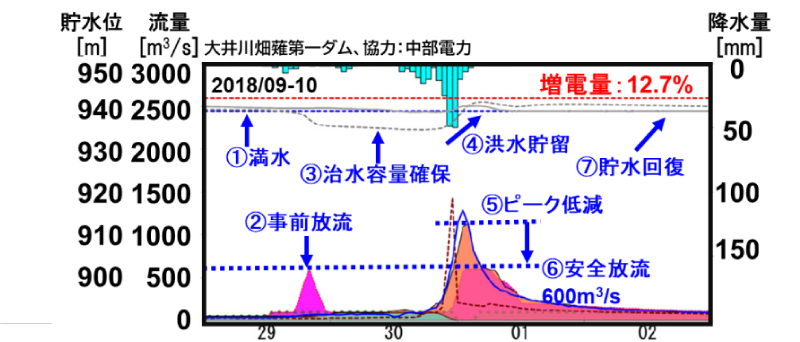In recent years, severe water-related disasters caused by unprecedented heavy rains have occurred annually throughout Japan. There is no doubt that global warming is causing climate change, and rainfall events are anticipated to become more extreme, resulting in more severe flood and drought damage. In response to these circumstances, including the 2019 typhoon, which caused significant damage to eastern Japan, the Ministry of Land, Infrastructure, Transport and Tourism in Japan has decided to take necessary actions in no time to maximize the use of the effective storage capacity of existing dams for flood control in emergencies and adopted the basic policy for enhancing the flood control functions of existing dams in December 2019.
To develop technologies to forecast rainfall and flooding several days in advance with high levels of accuracy for more effective preliminary dam discharges to reduce river flooding. To develop dam operational procedures according to levels of forecasting accuracy. To improve the accuracy of rainfall and runoff forecasting using ensemble forecasting.
The University of Tokyo, Nippon Koei Co., Ltd., Chubu Electric Power Co., Inc., TEPCO Renewable Power, Incorporated
FY2022-FY2027
| Chief Researcher | KUBOTA Keijiro |
| Senior Researchers | Mohamed Rasmy Abdul Wahid, USHIYAMA Tomoki |
| Research Specialist | TAMAKAWA Katsunori |
We developed a river-runoff ensemble forecasting system consisting of a rainfall ensemble forecasting system that can quantify the range of uncertainty in rainfall forecasts and WEB-DHM-S, which is a hydrological model that can seamlessly calculate different types of events from floods to droughts, including snowfall and snowmelt. Using rainfall ensemble-forecast data, WEB-DHM-S produces 32 ensemble-forecast dam inflows. The dam operation can be optimized considering the range of these 32 predicted inflows, in other words, based on the inflow forecasts in the upper section of the range if the operation prioritizes flood control or in the lower section of the range if the operation prioritizes water storage for more hydropower generation. We simulated the operation of the Hatanagi First Dam built on the Oi River by applying the following procedures. Supposing the dam reservoir is full at the start of dam inflow forecasting, a preliminary dam discharge is conducted to lower the dam reservoir’s water level and create a flood control capacity for coming inflow. The inflow is stored in the reservoir to keep the gate discharge at 600 m3/s or less, which is the safe discharge level to protect downstream areas. The dam stores water up to the reservoir’s high water level after the flooding time. The simulations using this approach for the warm season (July to October) in 2018 indicated a 12.7% increase in power generation. This method is applicable not only to domestic dams but also to overseas dams and is a promising technology that can significantly contribute to carbon neutrality in addition to improved flood control in many countries.

